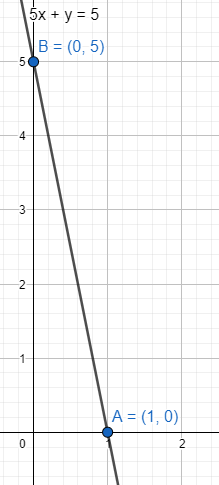
How do you graph $5x+y=5$ using the intercepts?
Answer
545.4k+ views
Hint: Change of form of the given equation will give the x-intercept and y-intercept of the line $5x+y=5$. We change it to the form of $\dfrac{x}{p}+\dfrac{y}{q}=1$ to find the x intercept, and y intercept of the line as $p$ and $q$ respectively. then we place the points on the axes and from there we draw the line on the graph.
Complete step by step answer:
We are taking the general equation of line to understand the slope and the intercept form of the line $5x+y=5$.
We change from the equation $5x+y=5$ to $y=-5x+5$.
The given equation is in the form of $y=mx+k$. m is the slope of the line. The slope of the line is $5$.
We have to find the x-intercept, and y-intercept of the line $y=-5x+5$.
For this we convert the given equation into the form of $\dfrac{x}{p}+\dfrac{y}{q}=1$. From the form we get that the x intercept, and y intercept of the line will be$p$ and $q$ respectively. The points will be $\left( p,0 \right),\left( 0,q \right)$.
The given equation is $5x+y=5$. Converting into the form of $\dfrac{x}{p}+\dfrac{y}{q}=1$, we get
$\begin{align}
& 5x+y=5 \\
& \Rightarrow \dfrac{5x}{5}+\dfrac{y}{5}=1 \\
& \Rightarrow \dfrac{x}{1}+\dfrac{y}{5}=1 \\
\end{align}$
Therefore, the x intercept, and y intercept of the line $5x+y=5$ is 1 and 5 respectively. The axes intersecting points are $\left( 1,0 \right),\left( 0,5 \right)$.

Note:
A line parallel to the X-axis does not intersect the X-axis at any finite distance. Hence, we cannot get any finite x-intercept of such a line. Same goes for lines parallel to the Y-axis. In case of slope of a line the range of the slope is 0 to $\infty $.
Complete step by step answer:
We are taking the general equation of line to understand the slope and the intercept form of the line $5x+y=5$.
We change from the equation $5x+y=5$ to $y=-5x+5$.
The given equation is in the form of $y=mx+k$. m is the slope of the line. The slope of the line is $5$.
We have to find the x-intercept, and y-intercept of the line $y=-5x+5$.
For this we convert the given equation into the form of $\dfrac{x}{p}+\dfrac{y}{q}=1$. From the form we get that the x intercept, and y intercept of the line will be$p$ and $q$ respectively. The points will be $\left( p,0 \right),\left( 0,q \right)$.
The given equation is $5x+y=5$. Converting into the form of $\dfrac{x}{p}+\dfrac{y}{q}=1$, we get
$\begin{align}
& 5x+y=5 \\
& \Rightarrow \dfrac{5x}{5}+\dfrac{y}{5}=1 \\
& \Rightarrow \dfrac{x}{1}+\dfrac{y}{5}=1 \\
\end{align}$
Therefore, the x intercept, and y intercept of the line $5x+y=5$ is 1 and 5 respectively. The axes intersecting points are $\left( 1,0 \right),\left( 0,5 \right)$.

Note:
A line parallel to the X-axis does not intersect the X-axis at any finite distance. Hence, we cannot get any finite x-intercept of such a line. Same goes for lines parallel to the Y-axis. In case of slope of a line the range of the slope is 0 to $\infty $.
Recently Updated Pages
Why are manures considered better than fertilizers class 11 biology CBSE

Find the coordinates of the midpoint of the line segment class 11 maths CBSE

Distinguish between static friction limiting friction class 11 physics CBSE

The Chairman of the constituent Assembly was A Jawaharlal class 11 social science CBSE

The first National Commission on Labour NCL submitted class 11 social science CBSE

Number of all subshell of n + l 7 is A 4 B 5 C 6 D class 11 chemistry CBSE

Trending doubts
What is meant by exothermic and endothermic reactions class 11 chemistry CBSE

10 examples of friction in our daily life

One Metric ton is equal to kg A 10000 B 1000 C 100 class 11 physics CBSE

1 Quintal is equal to a 110 kg b 10 kg c 100kg d 1000 class 11 physics CBSE

Difference Between Prokaryotic Cells and Eukaryotic Cells

What are Quantum numbers Explain the quantum number class 11 chemistry CBSE




